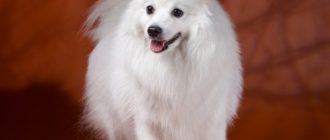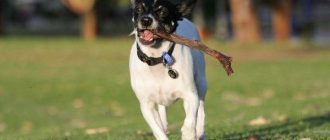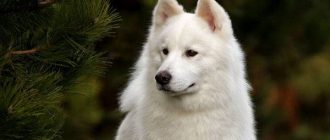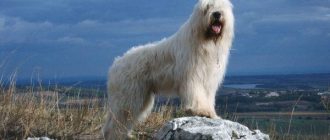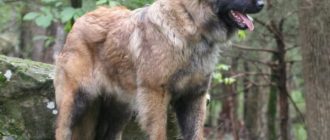Assessment of breed characteristics
Contents
| Adaptability Definition of how easy a dog is. can adapt to changes in life. |  |
| Shedding Level Level and frequency of hair loss in animal. |  |
| Level of tenderness Level and amount of tenderness and affection that the dog gives back in return for attention to itself. |  |
| Need for Exercise Daily Activity Level dogs. |  |
| Social need Required number of dog contacts with other animals as well as people. |  |
| Housing ratio Factor that determines the level of noise and other inconvenience that the dog can deliver to the owners in the ratio apartment size to dog size. |  |
| Grooming Number of bathing, combing, as well as necessary number of professional grooming sessions required the dog. |  |
| Friendliness in an unfamiliar environment society with strangers or in an unfamiliar environment. |  |
| The tendency to bark The tendency to bark and its frequency and volume. |  |
| Health Issues Potential Health Status dogs. |  |
| Territorial tendency of the dog to protect his house, yard or even a car owner. |  |
| Cat friendliness A trend towards cat tolerance and reduced manifestation of hunting instincts. |  |
| Intelligence Dog’s ability to think and solve emerging difficulties (not to be confused with learning!). |  |
| Education and training Level of difficulty in training a dog perform certain actions. |  |
| Friendliness for children Factor determining how much the dog friendly to children, whether she likes to play with them and endure some children’s pranks. |  |
| Game activity The concept is determined by its very name, and, usually found in almost all dogs. |  |
| Observing Dog’s ability to detect presence a stranger in his territory. |  |
| Friendliness for other dogs Dog’s tendency to find common language with other relatives. |  |
Brief description of the breed
Ca de bo – stocky and muscular dogs, excellent guards, caretaker and family members. Mastiff related, they are sometimes incorrect ranked as bulldogs, despite the fact that in the veins of these dogs there is blood of both. Other names of the breed – dog feather Majorcan, Feather de Pressomalorkin, Majorcan Mastiff (sometimes you can meet the name Majorca Bulldog) allow you to find out what the homeland of these animals – Mallorca (Mallorca) – Spanish island in the Mediterranean sea. In ancient times, the breed was used as a fighting breed (in dog fights and battles with bulls) and pickling (during bullfighting – national spectacle of the Spaniards). Today, more and more, ca de bo contain as a guard dog. Owners of dogs of this breed distinguish their basic qualities: strength, endurance, courage, kindness and loyalty to the owner and people close to him, alertness and willingness to engage in battle with the enemy. Ka de bo – dogs whose height is within 58 cm (in dogs) and 55 cm (in bitches). The weight of dogs ranges from 30 kg (in bitches) to 40 kg (in males).
Appearance
Head: massive, with a large skull in a square shape. Muzzle: The muzzle is wide, conical. The forehead is wide, with pronounced frontal groove. The transition to the muzzle from the forehead is pronounced. Chewing the muscles of the dog are clearly visible, with skin folds above them. Nose wide, black. Eyes of a dark shade, have an oval form, deep set. High set ears, pinkish (not stop). Neck: thick, proportional to the large torso dogs. Sometimes with a little suspension. Torso: chest cylindrical, deep. The body is muscular, lower back relatively narrow, with a vault in the area of croup. Observed high cheek. The belly is tight. Extremities: muscular (especially back), straight, widely spaced. Hips and forearms ca de bou wide, with embossed muscles. Paws are strong, oval in shape, with massive fingers. Tail: low set, broad at the base, tapers to the tip (does not stop). Coat: short, stiff. Color: brindle, black, fawn, red. Black mask possible colors and white markings on the muzzle, forelegs and chest.
Photo Ca de Beau:
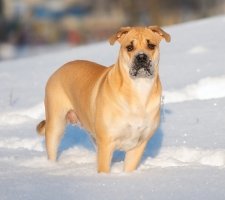
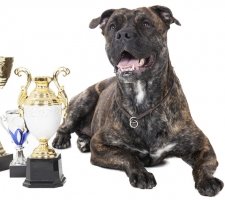

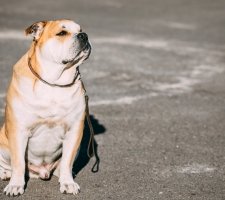
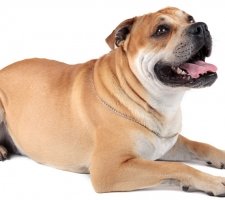
 Photo of dogs of the breed Ca de Bo |
Photo of dogs of the breed Ca de Bo |
Origin history
Disputes about the origin of these dogs do not cease. According to one version of ka de bo – descendants of the ancient Alans (almost extinct breed on today) and dogs feather de press canario (canary dogs), whose main functions were to protect the pasture from predator raids and homeowners protection. Imported in the 12-13th century into the Balearic the islands, these dogs gradually crossed with local animals, which subsequently allowed a new breed to be bred – ca de bo (“ca de bou “-” bull dog “) to delay the bull before slaughter, for fighting bulls and predators, home protection. Today’s feather de press Mallorquins were undoubtedly crossed with other inhabitants of the Pyrenees – Majorca herding dogs. Selection work was carried out on crossbreeding with bulldogs. According to another version, such dogs were descended from Iberian mastiffs known for their high fighting qualities during fights with bulls and their four-legged brothers. From 17 century mastiffs from Iberian (formerly Iberian) the peninsulas were crossed with fighting and guard dogs, which gave the world a new breed. The third version of creation – crossbreeding local Spanish etching dogs (for example, Cordoba dogs) with Old English Bulldogs in the early 17th century. However, such an opinion in fundamentally not supported by Spanish dog handlers who emphasize that there are not many bulldog blood, although the appearance between these dogs is a certain similarity. Rather, direct “relatives” of the Ca de Beau there were mastiffs that inhabited the territory of Spain since ancient times.
Character Ca de Beau
Although for a long time the dogs of this breed participated in the fighting, they are not aggressive and vicious. To host family members treat with love and devotion, adore children. To strangers look for a long time, trusting only their instincts. These dogs are wonderful guards, owners can fearlessly entrust them and your home and your life. Ca de bo infrequently raise barks, only in when necessary, when something disturbs them. Perfectly trained, active, like spending time in games. To the rest pets in the house are loyal, but more often dominate them without aggression. These four-legged are pretty balanced and smart. animals that are more likely to defend than attack. Love communication with all family members, but will not be necessary try to force yourself to show a lot of attention. In a word, these dogs are great for people with a big family and maybe a large territory that requires a reliable guard.
Maintenance and care
Majorcan mastiffs live as in an apartment (they are not you call it very large), and in the territory fenced reliable fence site in aviaries with a warmed booth. To the animal you need your own place where her bowls will stand, lie toys, the presence of beds for rest and sleep is mandatory. The wool of these the dogs are short, so that the warlocks and adhering dirt do not threaten them. Two-three – once a week combing with a special mitten for hair removal will help get rid of dead hair, and during molting can use a finisher for delicate removal old wool Bathing these dogs involves a two-time water treatments per year using good shampoo for short-haired dogs. In warmer weather, you can give the opportunity to bo swim in the pond. The owner should pay attention to eye condition of the dog, brushing ears twice a week, approximately twice cut the claws per month. Particular attention should be paid to folds on face of the dog after eating and walking, wiping food accumulations or dust to avoid irritating the dog’s skin. Ca de bo – dogs, who need frequent and quite active walks. therefore the owner needs to consider the possibility of walking the dog on special sites daily, for example, giving the dog a command “aport”. It’s great if the owner has the opportunity to sorties to nature with a pet at any time of the year – there the dog runs over plenty without a leash and danger to get under the car, and also will not involved in a brawl. In addition, snowy winter games or on the river in the summer will increase the load and diversify pastime of the dog. Young dogs will be helpful and it is interesting to play sports with your master, for example, accompany him on a bicycle or ski trip, during swimming time and other wellness treatments.
Training and training
Ca de bou education must begin with proper installation contact between the dog and its owner. At the same time, man should take a leading position, not allowing even a small puppy to commit inadmissible pranks (damage to furniture, bites, pursuit of cats, etc.) even for the sake of the game. Do not also communicate with the dog, using an overly soft or ingratiating tone. Ca de bo certainly feel that they can dominate the master, and then it will be it’s very difficult to properly train a dog to exist in society. So, classes with these dogs should begin with adaptation to life in the family and society, and only then you can start accustoming the baby to the collar and leash. It is soft and unobtrusive put on a dog’s collar daily, possibly turning this a ritual in a certain game, so that subsequently the animal does not have fear and discomfort associated with space limitations and of freedom. Ca de bo – dogs are very strong, stubborn, but enough obedient and easy to grasp the lessons of the owner. At first time a correctly executed team should be evaluated by the owner with a kind word (“well done”, “good”), if the puppy performs everything is true several times in a row, you can encourage him with a treat. On at first you should not punish the puppy, communicating in case of failure commands are too strict, you should not use physical force. Subsequently, when the dog will clearly understand the command, but by for any reason will resist their implementation, you can to influence it with the help of voice and mechanical impact (for example, pressure on the croup, but not beating). Besides Ca de bo teams often take a defensive course training because not only innate abilities should guided by the dog in protecting the owner’s life and entrusted to her territory, home. The protective course of training will increase many times protective abilities of a dog, will allow to detain a person, encroaching on the owner or his property, and then let go of team, without causing much harm to the offender. In other words, in the dog will combine the instinctive skills of protection from the dangerous a person under the control of the owner who can stop the dog if desired.
Health and Disease
The average life expectancy of dogs of this breed is 10-12 (sometimes 15) years. The breed does not differ in poor health. At proper care, monitoring the condition of teeth, eyes, ears, preventive examinations at the veterinarian these dogs will not often it’s hard to get sick. But they also have a number of “pedigree” diseases, among which: diseases of the musculoskeletal system (dysplasia hip and elbow joints, bursitis, tendonitis). Diseases cardiovascular system (myocardial infarction). Allergic skin reactions (dermatitis, pemphigus). Diseases gastrointestinal tract (coprostasis, digestive disorders).

